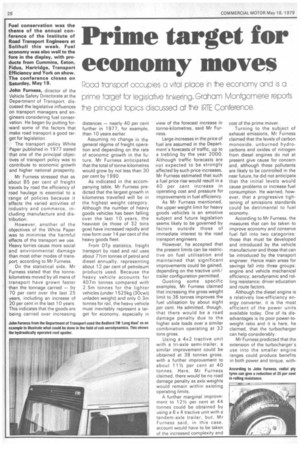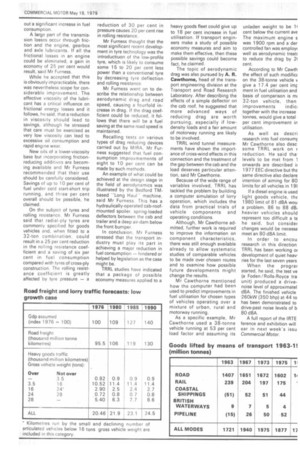Prime target for economy moves
Page 30

Page 31

If you've noticed an error in this article please click here to report it so we can fix it.
Road transport occupies a vital place in e economy anc is a prime target for leg islafive tinkering. Graham Montgomerie report the phncipal topics discussed at --)e IRIE Conference.
Fuel conservation was the theme of the annual conference of the Institute of Road Transport Engineers at Solihull this week. Fuel economy was also well to the fore in the display, with products from Cummins, Eaton, Fidus, Hartridge, Transport Efficiency and York on show. The conference closes on Saturday, May 19.
John Furness, director of the Vehicle Safety Directorate at the Department of Transport, discussed the legislative influences on transport managers and engineers considering fuel conservation. He began by putting forward some some of the factors that make road transport a good target for legislation.
The transport policy White Paper published in 1977 stated that one of the principal objectives of transport policy was to contribute to economic growth and higher national prosperity.
Mr Furness stressed that as about 85 per cent of freight travels by road the efficiency of road haulage is essential to a range of policies because it affects the varied activities of industry and commerce, including manufacture and distribution.
However, another of the objectives of the White Paper was to minimise the harmful effects of the transport we use. Heavy lorries cause more social and environmental damage than most other modes of transport, according to Mr Furness.
On the statistical side, Mr Furness stated that the tonnekilometres moved by all mens of transport have grown faster than the tonnage carried — by 70 per cent over the last 25 years, including an increase of 20 per cent in the last 10 years_ This indicates that the goods are being carried over increasing distances — nearly 40 per cent further in 1977, for example, than 10 years earlier.
Assuming no change in the general regime of freight operation and depending on the rate of economic growth in the future, Mr Furness anticipated that the total of tonne-kilometres would grow by not less than 30 per cent by 1990.
As indicated in the accompanying table, Mr Furness predicted that the largest growth in kilometres travelled will be in the highest weight category. Although the number of heavy goods vehicles has been falling over the last 10 years, the heaviest (ie those of 32 tons gcw) have increased rapidly and now form over 14 per cent of the heavy goods fleet.
From DTp statistics, freight transport by road and rail uses about 71/2m tonnes of petrol and diesel annually, representing about 12 per cent of petroleum products used. Because the heavy vehicle accounts for 407m tonnes compared with 2.5m tonnes for the lighter vehicles (under 1525kg (30cwt) unladen weight) and only 0.3m tonnes for rail, the heavy vehicle must inevitably represent a target for economy, especially in
view of the forecast increase in tonne-kilometres, said Mr Furness.
Large increases in the price of fuel are assumed in the Department's forecasts of traffic, up to a trebling by the year 2000. Although traffic forecasts are not expected to be strongly affected by such price increases, Mr Furness estimated that such a fuel price rise would result in a 40 per cent increase in operating cost and pressure for improvements in fuel efficiency.
As Mr Furness mentioned, the upper weight limit for heavy goods vehicles is an emotive subject and future legislation seems likely to be governed by factors outside those of immediate interest to the road transport engineers.
However, he accepted that the present limits can be restrictive on fuel utilisation and maintained that significant improvements could be gained, depending on the tractive unit/ trailer configuration permitted.
Quoting some specific examples, Mr Furness claimed that increasing the gross weight limit to 36 tonnes improves the fuel utilisation by about eight per cent. He admitted, though, that there would be a road damage penalty due to the higher axle loads over a similar combination operating at 32 tons gross.
Using a 4x2 tractive unit with a tri-axle semi-trailer, a similar improvement could be obtained at 38 tonnes gross, with a further improvement to about 11 1/2 per cent at 40 tonnes. Here, Mr Furness claimed, there would be no road damage penalty as axle weights would remain within existing operating limits.
A further marginal improvement to 121/2 per cent at 44 tonnes could be obtained by using a 6 x 4 tractive unit with a tandem-axle trailer, but, Mr Furness said, in this case, account would have to be taken of the increased complexity and
cost of the prime mover.
Turning to the subject of exhaust emissions, Mr Furness claimed that the levels of carbon monoxide, unburned hydrocarbons and oxides of nitrogen from diesel engines do not at present give cause for concern and, although these pollutants are likely to be controlled in the near future, he did not anticipate that the initial levels would cause problems or increase fuel consumption. He warned, however, that a progressive tightening of emissions standards could be detrimental to fuel economy.
According to Mr Furness, the measures that can be taken to improve economy and conserve fuel fall into two categories: those that must be developed and introduced by the vehicle manufacturer and those that can be introduced by the transport engineer. Hence main areas for savings fall into three groups: engine and vehicle mechanical efficiency; aerodynamic and rolling resistance; driver education and route factors.
Although the diesel engine is a relatively low-efficiency energy converter, it is the most efficient of the power units available today. One of its disadvantages is its poor power-toweight ratio and it is here, he claimed, that the turbocharger can help considerably.
Mr Furness predicted that the extension of the turbocharger's use into the smaller engine ranges could produce benefits in both power and torque, with out a significant increase in fuel consumption.
A large part of the transmission losses occur through friction and the engine, gearbox and axle lubricants. If all the frictional losses in an engine could be eliminated, a gain in economy of 25 per cent would result, said Mr Furness.
While he accepted that this is obviously impracticable, there was nevertheless scope for considerable improvement. The effective viscosity of the lubricant has a critical influence on frictional energy losses and it follows, he said, that a reduction in viscosity should lead to savings, although he stressed that care must be exercised as very low viscosity can lead to excessive oil consumption arid rapid engine wear.
New oils of a lower-viscosity base but incorporating frictionreducing additives are becoming available and Mr Furness recommended that their use should be carefully considered. Savings of up to 10 per cent of fuel under cold start-short trip running, and three per cent overall should be possible, he claimed.
On the subject of tyres and rolling resistance. Mr Furness said that radial-ply lyres are commonly specified for goods vehicles and, when fitted to a 32-ton combination, could result in a 25 per cent reduction in the rolling resistance coefficient and a saving of six per cent in fuel consumption compared with tyres of cross-ply construction. The rolling resistance coefficient is greatly affected by tyre pressure — a reduction of 30 per cent in pressure causes 20 per cent rise in rolling resistance.
Mr Furness thought that the most significant recent development in tyre technology was the introductiuon of the low-profile tyre, which is likely to consume some 15 to 20 per cent less power than a conventional tyre by decreasing tyre deflection and rolling resistance.
Mr Furness went on to describe the relationship between aerodynamic .drag and road' speed, causing a fourfold increase in drag. If the drag coefficient could be reduced, it follows that there will be a fuel saving at the same road speed is maintained.
Recalling tests on various types of drag reducing devices carried out by MIRA, Mr Furness suggested that fuel consumption improvmements of eight to 10 per cent can be made by such methods.
An example of what could be achieved at the design stage in the field of aerodynamics was illustrated by the Bedford TMbased "Long Haul" machine, said Mr Furness. This has a hydraulically-operated cab-roofmounted spoiler, spring-loaded deflectors between the cab and trailer and a deep air-dam below the front bumper.
In conclusion, Mr Furness stressed that the transport industry must play its part in achieving a major reduction in fuel consumption — hindered or helped by legislation as the case might be.
TRRL studies have indicated that a package of possible economy measures applied to a heavy goods fleet could give up to 18 per cent increase in fuel utilisation. If transport engineers make a study of possible economy measures and aim to make them effective, then these possible savings could become fact, he claimed.
The topic of aerodynamic drag was also pursued by A. R. Cawthorne, head of the transport engineering division at the Transport and Road Research Laboratory. After describing the effects of a simple deflector on the cab roof, he suggested that more advanced ways of reducing drag are worth pursuing, especially if lowdensity loads and a fair amount of motorway running are likely to be involved.
TRRL wind tunnel measurements have shown the importance of cross-wind effects in this connection and the treatment of the gap between the cab and the load deserves particular attention, said Mr Cawthorne.
Because of the wide range of variables involved, TRRL has tackled the problem by building a computer simulation of lorry operation, which includes the data from practical trials of vehicle components and operating conditions.
Although, Mr Cawthorne admitted, further work is required to improve the information on component characteristics, there was still enough available already to allow systematic studies of comparable vehicles to be made over chosen routes and to examine how possible future developments might change the results.
Mr Cawthorne mentioned how the computer had been used to predict improvements in fuel utilisation for chosen types of vehicles operating over a mixture of urban, rural and motorway running.
As a specific example, Mr Cawthorne used a 38-tonne vehicle running at 53 per cent load factor and assuming its unladen weight to be 11 cent below the current alit The maximum engine s was 1900 rpm and a der controlled fan was employi well as aerodynamic treati to reduce the drag by 21 cent.
According to Mr Cawth the effect of such modifici on the 38-tonne vehicle v give a 17.4 per cent imr ment in fuel utilisation and basis of comparison is mi 32-ton vehicle, then improvements indic; :together with the increase tonnes, would give a total per cent improvement in utilisation.
As well as descri research into fuel consumF Mr Cawthorne also desc some TRRL work on r reduction. He said tha levels to be met from 1 onwards are described ir 1977 EEC directive but tha same directive also declare intention of aiming for 80 limits for all vehicles in 191 If a diesel engine is used light goods vehicle, thE 1980 limit of 81 dBA wou a problem. 86 to 88 dB, heavier vehicles should represent too difficult a ta he said, but consider changes would be necessa meet an 80 dBA limit.
In order to encou research in this direction TRRL has been working or development of quiet heav ries for the last seven years When the prograr started, he said, the test ye (a Foden /Rolls-Royce tra unit) produced a drivenoise level of approximate! dBA. The finished vehicle '260kW (350 bhp) at 44 to has been demonstrated to drive-past noise levels of b 80 dBA.
A full report of the IRTE ference and exhibition will ear in next week's issu Commercial Motor.




















































































































